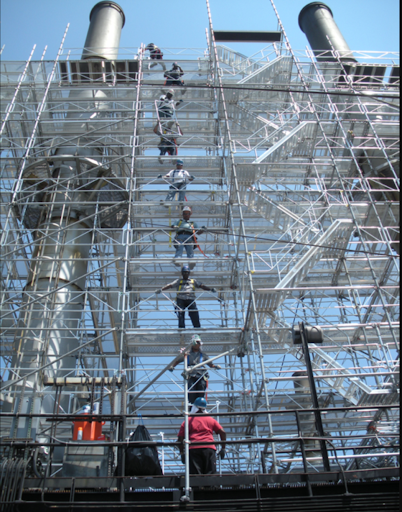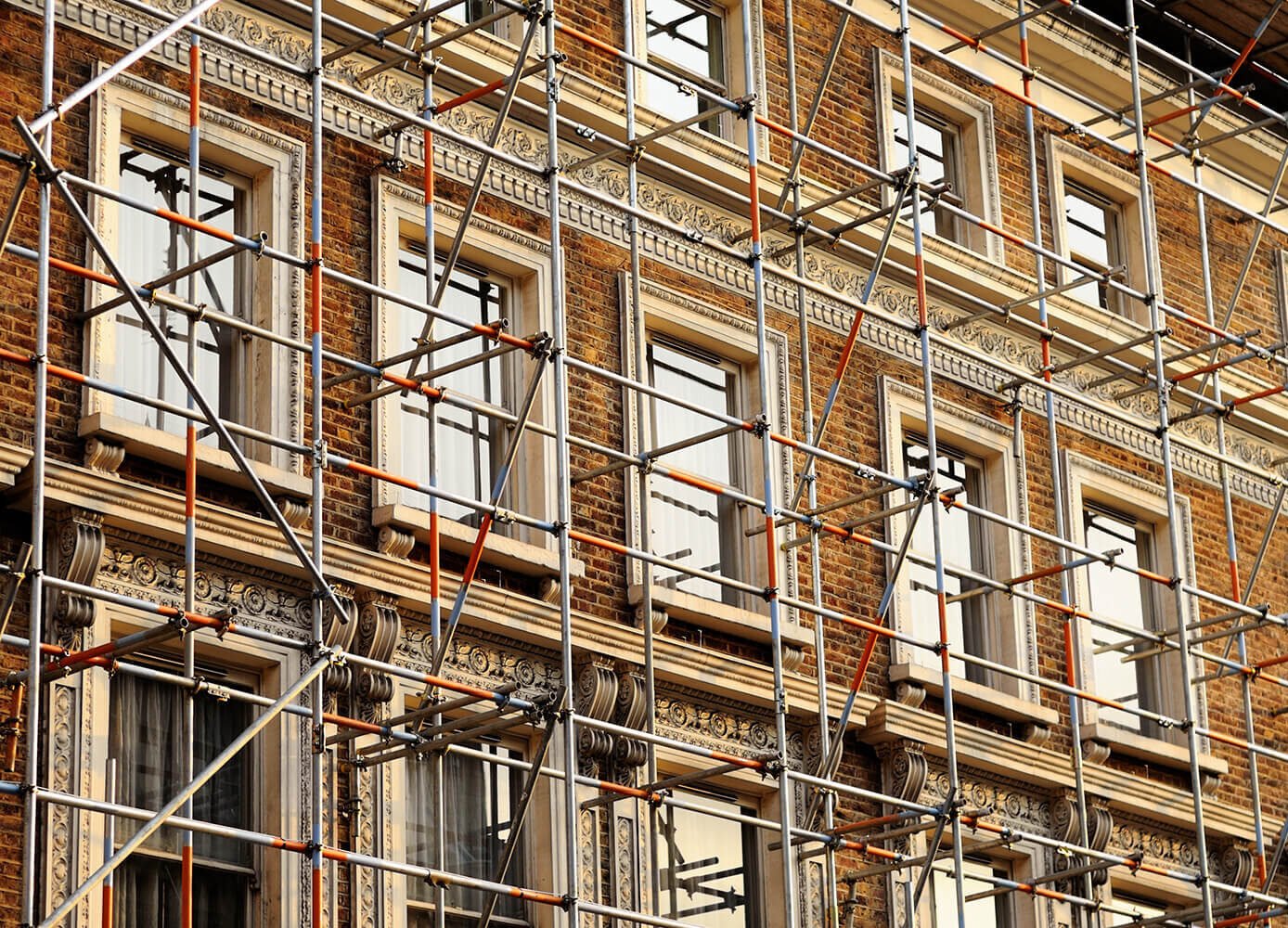Residential Scaffolding Solutions for Safe and Efficient Home Improvements
Residential Scaffolding Solutions for Safe and Efficient Home Improvements
Blog Article
A Comprehensive Guide to the Crucial Attributes of Scaffolding in Modern Building
The landscape of modern building and construction significantly depends on effective scaffolding systems that focus on performance, technology, and safety. As projects expand in complexity, recognizing the vital attributes of scaffolding ends up being crucial for making certain worker security and maximizing job timelines. This guide discovers numerous types of scaffolding, highlights vital security functions, and examines material improvements that add to performance and sustainability. The ramifications of these aspects expand much past mere building and construction methods, triggering a more detailed look at just how they affect total project success and worker well-being.
Kinds Of Scaffolding
Although scaffolding systems can vary extensively in style and application, they normally come under several distinct groups that provide to different building and construction demands - Scaffolding. The most common kinds consist of supported scaffolding, suspended scaffolding, and rolling scaffolding
Sustained scaffolding includes systems supported by a framework of posts, which give a elevated and stable functioning surface. This kind is commonly utilized for jobs that call for significant altitude, such as bricklaying or exterior paint.
Suspended scaffolding, conversely, is used for projects needing accessibility to high elevations, such as cleaning or fixing building exteriors. This system hangs from a rooftop or another framework, enabling employees to reduced or increase the system as needed.
Rolling scaffolding functions wheels that enable simple flexibility across a task website. It is specifically useful for tasks that need regular moving, such as indoor operate in big rooms.
Each kind of scaffolding is developed with certain applications in mind, ensuring that building and construction projects can be performed efficiently and successfully. Comprehending these groups is crucial for selecting the suitable scaffolding system to satisfy both task needs and website problems.
Trick Safety Functions
Security is vital in scaffolding systems, as the prospective threats connected with operating at heights can result in major mishaps otherwise appropriately taken care of. Secret security functions are vital to ensure the health of workers and the integrity of the construction site.
Firstly, guardrails are crucial. These obstacles supply a physical secure against falls, considerably minimizing the risk of major injuries. Additionally, toe boards are commonly used to avoid devices and materials from diminishing the scaffold, protecting employees below.
Another important component is making use of non-slip surface areas on platforms. This attribute improves hold, especially in adverse climate condition, thereby reducing the chance of slides and falls. In addition, gain access to ladders must be safely placed to promote risk-free access and departure from the scaffold.
Normal inspections and maintenance of scaffolding systems are also crucial. These assessments make certain that all parts remain in good problem and operating correctly, resolving any type of wear or damage quickly.
Finally, appropriate training for all workers included in scaffolding operations is important to make certain that they understand security protocols and can determine prospective dangers. Scaffolding. Collectively, these features develop a more secure working atmosphere and dramatically alleviate risks connected with scaffolding
Material Innovations
Advancements in material scientific research have significantly influenced the scaffolding market, enhancing both security and effectiveness in contemporary building. The introduction of high-strength steel and light weight aluminum alloys has actually changed typical scaffolding systems.
Additionally, cutting-edge composite materials, such as fiberglass-reinforced plastics, have arised as sensible options. These materials are resistant to corrosion and environmental deterioration, thus expanding the life-span of scaffolding systems, especially in harsh climate condition. Making use of such materials adds to lower upkeep expenses and ensures constant efficiency in time.


Style Considerations
Thinking about the intricacies of modern-day building and construction jobs, effective scaffolding layout is extremely important to guaranteeing both capability and safety. Layout considerations should incorporate different variables, consisting of lots ability, height, and the details needs of the building website. Each job offers special difficulties, demanding an adaptable approach to scaffolding systems that can adjust to varying problems.
Architectural honesty is critical; for that reason, engineers should determine the tons that the scaffolding will certainly support, consisting of workers, materials, and devices. The option of materials plays a critical duty in making certain the scaffolding can stand up to these tons while continuing to be sturdy and lightweight. Furthermore, the layout needs to enable very easy access and egress, promoting the smooth my website motion of employees and materials.
Security functions, such as guardrails and non-slip surfaces, ought to be incorporated to decrease threats of accidents. Moreover, the format has to take into consideration the surrounding atmosphere, consisting of potential hazards and surrounding frameworks. By attending to these design factors to consider, building and our website construction firms can improve the performance of scaffolding systems and advertise a more secure working setting, eventually adding to the general success of the project.
Maintenance and Inspections
The effectiveness of scaffolding systems extends beyond preliminary layout and execution; recurring upkeep and regular evaluations are important to guaranteeing their continued performance and safety and security throughout the duration of a project. Routine examinations should be carried out by certified workers to identify any signs of wear, damage, or instability that can endanger the stability of the scaffolding.
Upkeep procedures need to consist of regular checks of architectural components, such as installations, planks, and structures, making certain that all aspects remain complimentary and secure from rust or other wear and tear. Furthermore, the functionality of safety attributes, such as guardrails and toe boards, have to be analyzed to guarantee compliance with security guidelines.
Documentation of all assessments and upkeep tasks is critical for responsibility and governing compliance. A methodical strategy to record-keeping not just help in website here tracking the condition of the scaffolding yet likewise gives essential evidence in the occasion of an incident.
Eventually, developing an extensive upkeep and examination schedule will significantly decrease the threat of mishaps and improve the general safety of the building site. By prioritizing these techniques, construction managers can safeguard employees and promote the project's stability.

Verdict
Finally, the vital functions of scaffolding in modern construction incorporate a variety of vital aspects, including varied kinds, crucial security mechanisms, material innovations, and thoughtful layout factors to consider. Highlighting safety through guardrails and non-slip surfaces, alongside innovations in products like high-strength steel, enhances both efficiency and sustainability. Routine upkeep and evaluations are vital for ensuring structural honesty and security on building and construction sites, inevitably helping with reliable project implementation and advertising the wellness of employees.
The landscape of contemporary building significantly counts on efficient scaffolding systems that prioritize advancement, performance, and safety.Improvements in product scientific research have actually substantially affected the scaffolding sector, enhancing both safety and effectiveness in modern-day construction. Generally, these product technologies not just boost the efficiency and safety of scaffolding systems however likewise line up with the market's press in the direction of sustainability, as lots of modern products are created to be extra ecologically friendly.
Taking into consideration the intricacies of contemporary building and construction projects, effective scaffolding style is paramount to ensuring both functionality and safety.In conclusion, the vital functions of scaffolding in contemporary building encompass a variety of essential components, consisting of diverse types, key safety and security mechanisms, material technologies, and thoughtful layout factors to consider.
Report this page